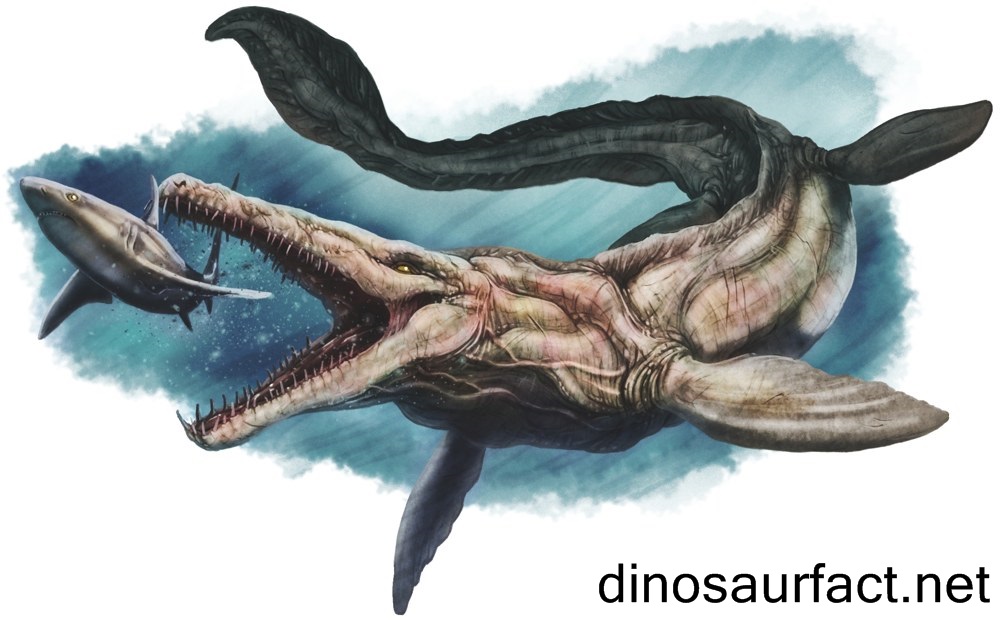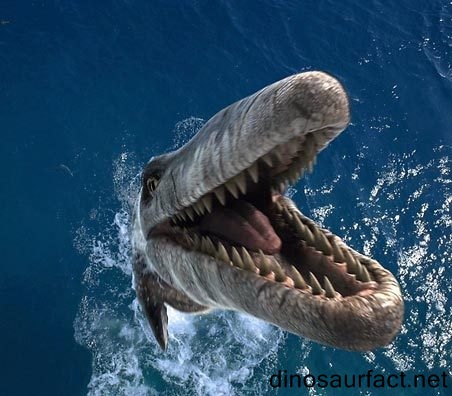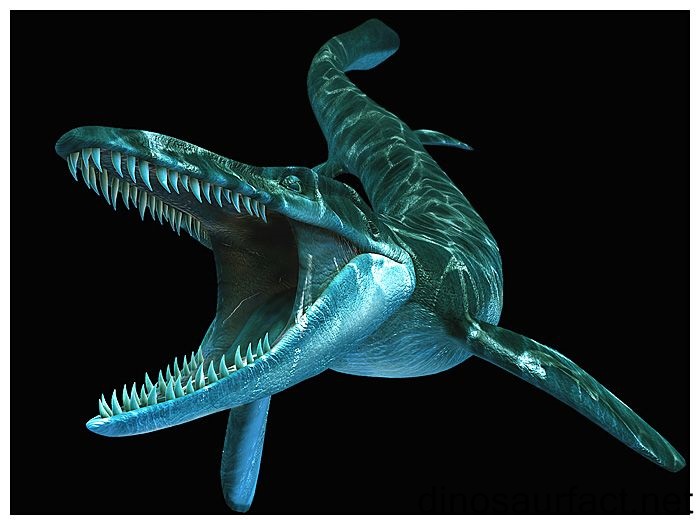 Click to visit the previous Marine Specie bio
Click to visit the previous Marine Specie bio
 |
|
 |
|
Kingdom: Animalia
Phylum: Chordata
Class: Reptilia
Order: Squamata
SubOrder: Scleroglossa
Family: Mosasauridae
Genus: Tylosaurus
 |
|
 |
|
 |
|

The Tylosaurus was an extremely large aquatic reptile which existed on the earth during the second half of the Cretaceous period. It is classified under order Squamata, which comprises of scaled reptiles like lizards and snakes. It is probably related to the present day monitor lizards like the Varanus. It belonged to family Mosasauridae. Mosasaurs were amongst the most successful predators of the Cretaceous period.
The Tylosaurus was in existence about 89 to 80 million years ago. This lies in the Turonian to Campanian ages of the Cretaceous period. This phase was relatively late in the Cretaceous period and it had evolved from the other carnivorous reptiles from the Triassic and Jurassic periods. It was completely adapted for a marine habitat.
The Tylosaurus was one the largest Mosasaurs ever to seen. In fact it was amongst the largest creatures to ever swim the oceanic waters. It grew an impressive size of 16 meters. Its weight is approximated at about 15 to tons. Certain specimens of the Tylosaurus had dimensions even larger than the ones mentioned above.
As large as it was, the Tylosaurus wasn't the biggest creature in its group. The largest mosasaur was the Hainosaurus.
Etymology
The prefix 'tylos' is a Greek term which means 'projection'. The suffix '-saurus' is derived from the Greek word 'sauros' which translates to lizard in English. Thus meaning of the name 'Tylosaurus' is 'the lizard with the projection'.
It was believed that the Tylosaurus had a very prominent cartilaginous ridge on its skull. There is no evidence that it possessed such a crest. But it was still named accordingly.
Discovery of fossils
- The remains of the Tylosaurus were discovered by O.C. Marsh. They were found in the midst of his competition with E.D. Cope. Marsh discovered the holotype in the year 1868 in Gove County in Kansas.
- Four years later, Marsh found another skeleton in Kansas, but this one consisted of more bones and was better persevered. He grouped it with his 1868 find.
- The largest specimen of the Tylosaurus was discovered in the year 1911 in Wallace.
- A Tylosaurus specimen was discovered in 1918 with its stomach contents intact. It had a plesiosaur in its belly.
- The most recent remains of the Tylosaurus were discovered in 2009. They were found in Logan County.
Nature of fossils
Many of the Tylosaurus skulls show the presence of fractures. These fractures look like they were caused by impact with a hard object. This raised the question of the reason of these injuries. Scientists speculate that the Tylosaurus exclusively used the strength of its jaws to subdue its prey. It probably received those wounds while attacking larger marine animals.
The skull of one of the Tylosaurus specimen showed bite marks. Since it was one of the largest animals in its environment, paleontologists believe that these marks could have been made by another larger Tylosaurus. This shows that intra species competition between Tylosaurus individuals was fierce.
Classification
- The Tylosaurus is classified under suborder Scleroglossa, family Mosasauridae and subfamily Tylosaurinae. These divisions were not defined when the fossils of the Tylosaurus were discovered.
- Marsh had classified the remains of the Tylosaurus under the name Macrosaurus.
- He later reassigned them to the genus Liodon.
- The fossils discovered in 1872 were christened ‘Rhinosaurus’. But since this name was already occupied, the name ‘Rhamposaur’ was chosen for them. Incidentally, Rhamposaurus was also unavailable and thus Marsh coined the name Tylosaurus.
- The bones attributed to the Liodon were later grouped with the Tylosaurus.
- The name of the genus was fixed in 1872, but its exact taxonomic location remained unclear for many decades.
- Many subspecies were defined under the genus over the years, but today only six are recognized, with the T. proriger being the type species.
O. C. Marsh
Othniel Charles Marsh was one of the notorious participants of the late nineteenth century American ‘Bone wars’. By the by, Marsh was the eventual victor of this competition.
Marsh was born in Lockport and graduated from the Yale University. His major was geology at Yale.
Driven by a need to achieve fame as well as a love for science, Marsh initiated a race with Edward Drinker Cope to uncover the maximum number of dinosaur fossils. His plan worked both ways; he discovered and named more fossils than Cope and received wide spread fame.
Well known dinosaurs such as the Stegosaurus, Apatosaurus and the Triceratops were defined by O. C. Marsh.
Physical characteristics
- The Tylosaurus was a huge reptile. The largest specimen was more than 50 feet in length and weighed about 25,000 kilos.
- The upper jaw of the Tylosaurus was modified to form a long snout, which is one of the its typical features.
- Its body was streamlined, with its limbs being modified to form flippers.
- The fore limbs and hind limbs of the Tylosaurus were almost of the same size.
- There was misconception prevalent in the late 1800s that the Tylosaurus had a hump on its dorsal surface. If the hump indeed existed, it should have been made up of soft tissue. Such structures are difficult to judge based on bony fossils.
- The Tylosaurus had a very long tail. This tail was expected to be very thick. Many artists have depicted the Tylosaurus with having a beaver-like tail. But most scientists agree that it would have been bi-lobed.
Habits and habitat
The feeding habits of the Tylosaurus were carnivorous. Its fossils had contained the remains of plesiosaurs, sharks, fish and even other Mosasaurs. Fights amongst Tylosaurus individuals were also common, but scientists have found no evidence of cannibalism.
It is unknown whether the Tylosaurus was oviparous or viviparous. It is extremely likely that it gave birth to live young ones.
The Tylosaurus is believed to have resided in the shallow waters around North America. It may not have lived near the coast, but it did not venture very deep into the ocean. This can be deduced by the number of its discovered fossils.
Related species
The Tylosaurus was related to the Tethysaurus and the Ectennosaurus.
The Mosasaurs had evolved from a different ancestor as compared to ichthyosaurs and plesiosaurs. The Tylosaurus lineage was different than its contemporary carnivorous reptiles.
Concluding notes
The Tylosaurus was a ferocious predator. It was also one of the largest marine reptiles to ever live on the earth.
No marine animal was safe from the Tylosaurus; not even the Tylosaurus itself as individuals were known to attack their own kind.
Index
Extinct Profiles
 Triassic Dinosaurs
Triassic Dinosaurs Jurassic Dinosaurs
Jurassic Dinosaurs Cretaceous Dinosaurs
Cretaceous Dinosaurs Pterosaurs
Pterosaurs Marine Reptiles
Marine Reptiles Dinosaur Extinction
Dinosaur Extinction